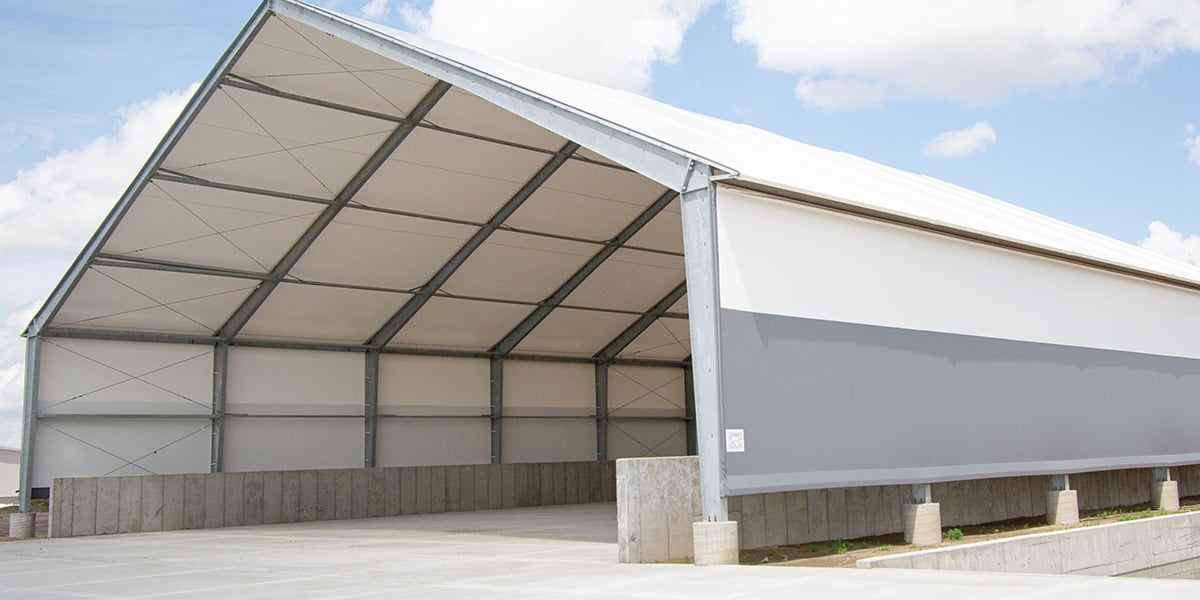Get More From Your Bulk Storage Building

Bulk fertilizer and commodity storage may seem like a relatively simple business: increase capacity as much as possible while keeping the per-bushel storage cost low. But of course things are rarely that simple.
Bulk storage buildings must also account for safety, climate and product handling. Adding architectural features and accessories to a flat grain storage building can ultimately make the entire operation more efficient and more profitable.
Precast Concrete Walls
Precast concrete has two popular uses in bulk storage building design: stem walls and storage bins. Precast panels are less expensive than cast-in-place concrete, and it is a portable asset if the building is ever relocated.
Precast concrete walls have a higher load-bearing capacity than the sidewalls traditionally used in fabric buildings. This enables material, including pulses, fertilizer and grains, to be piled right to the edges of the building – making full use of the interior square footage by eliminating dead zones.
Learn the advantages of precast concrete walls for bulk storage.
Attached Conveyors and Cranes
All material must be moved in and out of any storage system. For large operations, complete turnover happens several times per year. This makes it critically important to the most efficient loading equipment.
Free-standing conveyors require floor space for support. Heavy equipment operators must take special care not to collide into the legs, which could damage the conveyor and result in lost time and replacement costs. Portable augers, conveyors and front-end loaders don’t have the capacity to move the bulk product required by commercial fertilizer and seed distributors.
Adding a conveyor and crane to the building frame gives the building operator access to the heavy-duty equipment required to maximize loading time. Attached conveyors maximize loading and transloading without taking up precious floor space. Read a case study.
Lean-To's
A lean-to is a building addition along one wall of the building. Lean-tos create additional space inside the building at a minimal cost and while requiring a smaller amount of land than simply increasing the building size.
Lean-tos in a bulk storage building are used to create a circulation path and to provide space for operations, including equipment maintenance and storage. Some fertilizer storage operations use a lean-to as additional space for offices and retail.
A lean-to is a simple addition to the building with several options it fits for its purpose. The lean-to may be open to the main building or enclosed. It may be insulated or heated differently from the building.
Passive Ventilation
Ventilation assists in regulating the building’s interior temperature and preventing condensation. Cool temperatures are especially critical for preventing spoilage in stored grains and pulses. Passive ventilation takes advantage of the natural properties of gravity to provide a constant source of cool, fresh air inside the building.
Active ventilation options are also available. Learn more.
Overhangs are one way to provide fresh air intake – they run the length of the building and are closer to the occupied level. Overhangs with a mesh soffit allow air into the building while keeping birds and pests out.
Warm air exhaust is most common at the peak of the building. Once installed at the peak of the building, ridge vents require no additional maintenance. Ridge vents may be low-profile to better blend in with the roof of the building.
While adding options to a bulk storage building will increase the initial purchase price, the money saved over the building’s lifespan can easily make up the difference. Contact a fabric structure consultant to learn more.
Subscribe to our Blog
Recent Posts
- 5 Factors Every Project Owner Should Consider Before Approving Building Materials
- The 20-Year View: How Material Choices Impact Long-Term Operational Costs
- Climate Resilience in Commercial Construction: Why Traditional Methods May Not Be Enough
- Speed and Quality: The Role of Hybrid Building Materials
- Beyond the Bleachers: Designing Visually Striking Sports Facilities
